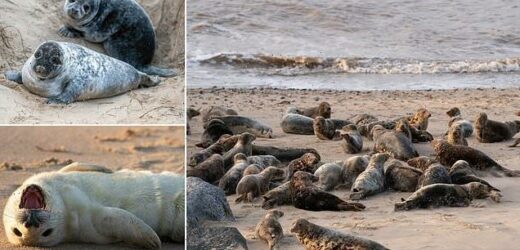Norfolk’s seal pup population hits a record high: Nearly 4,000 baby seals are spotted along a five mile stretch of coast – almost DOUBLE the count from 2019
- The seal pup population has grown dramatically on the Norfolk coast this year
- Between Waxham and Winterton the number counted has boomed to 3,796
- The growing seal colony is down to a large amount of fish and high dunes
- The British coast is home to almost half of the world’s population of grey seals
Almost 4,000 baby seals have been spotted on a five-mile stretch of coast in Norfolk – almost double the count from 2019.
Each year, the seal population between Waxham and Winterton attracts thousands of visitors as young seals are weaned before re-entering the sea.
So far, this seal watching season, a total of 3,796 seal pups have been born and 1,169 adults have been spotted.
Back in the winter of 2019/2020 the total pup count was much lower than this year’s population, standing at 2,069.
Almost 4,000 baby seals have been spotted on a five-mile stretch of coast in Norfolk – almost double the count from 2019
Peter Ansell, chairman of Friends of Horsey Seals, said: ‘It is a sign of a healthy colony.
‘It’s down to the fish, at the moment the North Sea is providing enough fish for thousands of seals, and this is a nice place for them to come ashore and do their breeding.
‘They are very popular with visitors, which is funny because they don’t really do anything, they come ashore and flop down and every few hours the pup nudges the mum for a feed.’
So far this seal watching season, a total of 3,796 seal pups have been born and 1,169 adults have been spotted. Pictured: Two grey seal pups on the beach at Horsey in Norfolk
How to see seals without disturbing them
Seals are wild animals, so it is best to follow these rules if you find yourself on a beach with a seal, according to the Norfolk Coast information site:
- Keep a minimum of 10 metres, or further, away from any seal and move quickly
- Stay on the landward side of the seal
- Keep your dog on a lead
- Watch out of seals
- Do not approach a seal
- Take care of the surrounding environment, such as sand dunes
Almost half of the global population of grey seals live around the British coast, with Norfolk being an important breeding site.
This is because it is home to flat beaches, shallow waters and high dunes, particularly around the Horsey and Winterton area, offering good conditions for female seals to give birth.
Seals can thrive in this part of the world as they have no predators hunting them and have little disturbance from humans.
The population rise was predicted by experts in the area last year.
During the 1980s a small proportion of seals were born in Blakeney Point in Norfolk but the population has since exploded, rising from 69 to almost 4,000.
National Trust ranger Carl Brooker told ITV News in 2021: ‘It’s absolutely incredible that we can see it growing and growing every year, because a lot of the time, particularly, if you read in the papers, a lot of it is doom and gloom – “we’ve lost this and we’ve lost that” – but you come to Blakeney Point and we’re gaining wildlife every year.’
There are concerns, however, that climate change may impact the future of the seal populations, due to flooding, which could impact the seals’ ‘fragile environment’.
Mr Brooker added: ‘If we get too many of these high seas and too much of these things happening in the winter, we are going to lose Blakeney Point.
‘It’s just a thing that we need to be most wary of. At the moment, we’re lucky and we’ve got loads of seals here, but it is a fragile environment.’
These are the best locations to spot seals along the Norfolk Coastline. Common seals have their young between June and August whereas Grey seals have their young between November and January
Almost half of the global population of grey seals live around the British coast, with Norfolk being an important breeding site. Pictured: A newborn grey seal pup on the beach at Horsey in Norfolk
Visitors are asked to keep at a distance and keep their dogs on a lead while the pups are ashore in the winter months until about February.
Norfolk is home to both Grey seals and Common seals.
Grey seals are generally bigger with specks on their coats, and have longer heads with parallel nostrils.
They spend most of their time lying on British beaches, out of the sea after feeding on fish.
According to the Wildlife Trust, in the early 20th century there were only 500 seals in and around Britain.
The charity now estimates there are more than 120,000 grey seals in Britain, making up 40 per cent of the world’s population and 95 per cent of the European population.
Common seals, meanwhile, have a more rounded head and ‘v’ shape nostrils.
They are often found on sheltered shores and estuaries on sandbanks and beaches.
Common seals feed on fish like Grey seals but also each squid, mussels, crabs and whelks.
Born in the summer, their pups can swim when they are only a few hours old, according to the Wildlife Trust.
The best time to see seals at Blakeney Point is during the summer months, whereas the peak seal season at Horsey is during the winter birthing season.
Grey seals can be found all over the UK, whereas Common seals are generally found off the coast of Scotland, Northern Ireland and Teesmouth and eastern England.
Where to see wild seals in Norfolk
The North Norfolk Coast is one of the best areas in the UK to see seals.
Common seals have their young between June and August whereas Grey seals have their young between November and January.
These are the best places to spot them according to the Norfolk Coast information site:
- Blakeney Point: Home to the largest colony of grey and common seals in England. It has been run by the National Trust since 1912
- Horsey Beach: It’s one of the most wild beaches where you can spot plenty of seals and do not have to get a boat ride to see them
- Hunstanton: The seals are not usually found on the beach here so it is best to take a boat tour to the sandbanks in The Wash.
- Winterton Beach: This is a popular spot where seals can be spotted swimming in the water
- Waxham Beach: This less well known site has no official parking but often has seals venturing out from the Horsey colony
The Norfolk coastline is one of the best places to see seals in the whole of Britain. Pictured: A young grey seal waiting for its mother to return from sea
Source: Read Full Article







